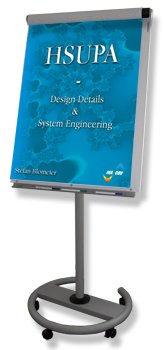 HSUPA - Design Details & System Engineering
HSUPA - Design Details & System Engineering
[2-day course, Euro 2,350.- (net) per participant]
 Training Course Description
Training Course Description

- This training course appeals to all engineers and technicians who want to gain expert knowledge about the key functions of HSUPA like E-TFC selection (E-DCH Transport Format Combination) or scheduling grants.
- The training course focuses on the necessary extensions of the UTRAN architecture in NodeB and the UE, in order to explain in detail the requirements for HSUPA. Further emphasis is on the protocol enhancements like MAC-es/MAC-e and the new physical channels.
- Special focus is put on UE’s physical layer aspects, which allow a higher user data throughput in the uplink far beyond the conventional 64kbit/s. In that respect, the uplink scheduling mechanism located in the NodeB is of central importance for HSUPA granting maximum allowed power ratios to each E-DCH capable UE.
Please click here for a detailed Table of Contents (ToC)
Some of your questions that will be answered
- What are the motivation and drivers for HSUPA?
- Supported data rates with HSUPA?
- What are the key concepts of HSUPA?
- What impact does HSUPA have on the system architecture?
- What is the purpose of E-DCH (Enhanced DCH) and E-TFC?
- Is there a new modulation scheme coming with HSUPA?
- What are the advantages for the subscriber using HSUPA capable UE’s?
- How are HARQ and Fast Packet Scheduling done?
- What are the differences and pros/cons between HARQ II and HARQ III?
- What are the impacts of HSUPA in Iub & Iur User and Control Plane?
- What adaptations are required on the UE and network side to provide for HSUPA?
- How does the F-DPCH benefit UTRAN?
- What is the purpose of Primary and Secondary E-RNTI?
- Why are Absolute and Relative Grants used to control UE’s uplink E-DPDCH Power?
- What are the differences between E-DCH Serving RLS and E-DCH Non-Serving RLS?
- When are scheduled and when are non-scheduled Grants issued?
 Who should attend this class?
Who should attend this class?
- Everybody who needs to design HSUPA capable UEs and network equipment
- Operators who need a detailed understanding of HSUPA
- Test engineers who need to integrate HSUPA equipment and UEs
 Pre-Requisites
Pre-Requisites
- Very good understanding of WCDMA networks, protocols, operation and parameters. Previous knowledge of UMTS-details from our training training course “UMTS Design Details & System Engineering” is advantageous. In addition, we advise our training course “UMTS – Signaling & Protocol Analysis (UTRAN & UE)” to be taken in advance.
- Previous design and/or testing experience with WCDMA-networks and / or User Equipment are favorable.
- As every E-DCH capable UE has to mandatory support HSDPA, a profound knowledge of HSDPA is highly beneficial for the understanding of HSUPA.
 Training Course Target
Training Course Target
- The student will be enabled to understand all relevant details of HSUPA within the UTRAN and the User Equipment.
- The participant is enabled to develop, test and operate HSUPA hard- and software.
 Training Course Duration
Training Course Duration
- 2 days
v1.51
ℹ️ Try out the updated search below!
Search:
More Info:
Detailed ToC of this training course
Schedule of this training course
Extract of this training course
Buy this book
Buy this book as eBook
INACON eBooks
Please have a look at our full offer

